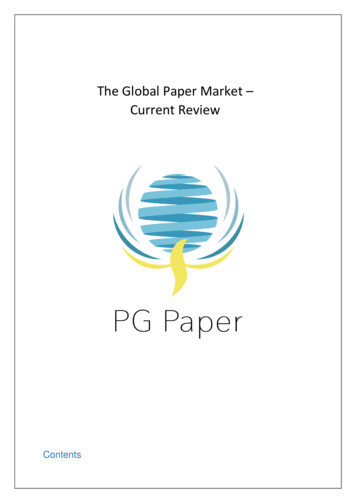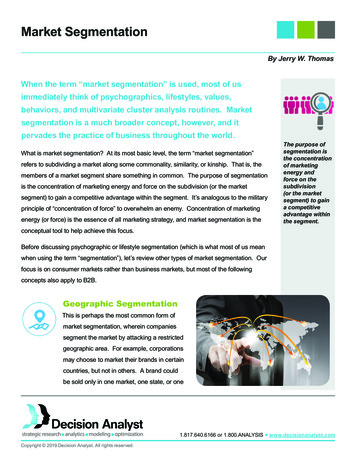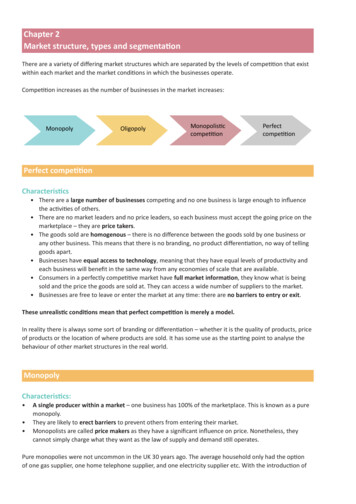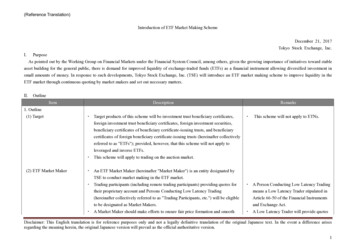
Transcription
The Global Paper Market –Current ReviewContents
Introduction . 2Current Global Outlook for the Paper Industry . 4Key players & Risk Rating . 4China . 5The USA . 5Japan . 5Global paper and board industry outlook . 5Strength and weakness of the industry . 7Economic and credit outlook of the global paper industry . 8Production & Consumption . 9Global Demand by Paper Product . 10Debt and EBITD of Chinese companies. 11Debt and EBITD of American and European companies . 12Conclusion . 13References . 141
IntroductionThe pulp and paper industry is one of the largest industries in the world. It is dominated byNorth American, Northern European and East Asian companies. Latin America andAustralasia also have significant pulp and paper industries. Over the next few years, it isexpected that both India and China will become key players in the industry.World production of paper and paperboard is around 390 million tonnes and is expected toreach 490 million tonnes by 2020. The pulp and paper industry is a large and growingportion of the world's economy.The pulp and paper industry is faced with mounting environmental, political, and economicpressures to reduce the volume and toxicity of its industrial wastewater. During the last fewyears, the concept of system closure has been gaining popularity in the forest productsindustry for the following reasons: The concept offers more flexibility in the siting of new mills, including considerationof mill locations with limited fresh-water resources.2
Offers increased opportunities to maintain or expand production in environmentallysensitive locations. Offers more favourable market and environmental evaluation of products, includingthe provision of a more durable solution to future environmental standards. Drastically reduces or even eliminates liquid discharges and the associated waterquality problems. Separates and recycles valuable resources. Preserves energy that can be used to reduce the cost of production and amortizecapital costs. Saves on capital and operating costs for effluent treatment in addition to savings onchemicals and heat. Reduces the use of fresh water.These prospects have encouraged the emergence of new and innovative zero liquiddischarge or closed-cycle systems which, when implemented in a mill, will enable therecovery of clean process water from the effluent and recycle it back into the mill. For manyyears, the pulp and paper industry has been in pursuit of a closed-cycle pulp mill. The drivingforces behind this prolonged effort vary from company to company. It appears that one of theoverriding goals has been to leave at least one environmental stage altogether and toperhaps get government regulatory compliance agencies and environmentalists off theindustry's back once and for all.In recent years, several economic driving forces have also emerged. Many companies areinvestigating effluent closure or at least minimum-impact possibilities because they offerseveral economic benefits. For the most part, mills working toward minimum impact orbleach plant filtrate closure have not attempted to take advantage of this approach in themarketplace. Several mills in Scandinavia have placed TEF (totally effluent-free) or MIM(minimum impact mill) products on the market, seeking premiums, but have not achievedany significant success. But effluent closure or minimum impact could become a fairlysignificant marketing tool for the pulp and paper industry in the twenty-first century.3
Current Global Outlook for the Paper IndustryFigure 1:1 Outlook of the paper industry (Risk)A medium rating is based on: European paper and pulp buyer squeezed by input cost vs. USDend product prices.There has been an big impact of increasing price of the powersectorCurrency rate fluctuation is also a big concern ( USD vs. Euro )Paper recycling in the industry ( as a whole ) is in light of theglobal energy transitionFurthermore, the outlook for the global paper and forest products industry remains stableand overall operating earnings are predicted to grow modestly over the next 12 to 18months, though escalating costs will dampen the benefit of higher prices. Among subsectors,such as packaging, tissue, timber, wood products, and market pulp segments these allcontinue to carry stable outlooks, while the outlook for the paper segment remains negative.Key players & Risk RatingCountryRoleRisk in sectorChinaConsumer/ProducerSensitiveUnited stateProducerMediumJapanProducerMedium4
ChinaIn recent years, the Chinese market has begun to address the environmentalhazards posed by the obsolete capacity. The imposition of environmental protectiontaxes directly replaced sewage charges and are incorporated into local governmenttaxation systems. This means non-compliance companies will face more stringentsupervision. However, the large-scale paper manufacturers with the advantages interms of pollutant emission per tonne will be more profitable through tax reduction.The USAThe USA has strong cost control ability that stabilises their profitability, but theproduct line diversification puts some traditional paper business under pressure dueto profitability differentiation. However, considering the uncertainties in globalmacroeconomic development and the economic growth slowdown in developingcountries, the expected market demand of paper industry is still weak, and there is adownward pressure on the whole industry. Non-compliant pollution activities in theUnited States under the regulatory regime will directly affect a company’s follow-upoperations.JapanThe paper industry in Japan will continue to be the main driving force for the steadygrowth of the global paper industry, in which packaging paper and household papercompanies have a better development prospect. The increasing cost of raw materialshas been a problem. Due to capacity reduction and continuous environmentprotection, paper prices have increased. The average operating income of samplecompanies presents an upward trend, (which has increased by about 27% in the firsthalf of 2017 compared to the year earlier).Global paper and board industry outlook5
Global paper and board industry outlook,breakdown by region % in volumes50454035302520151050EuropeNorth AmericaAsiaLatin AmericaProductionOthersConsumptionFigure 2: Global paper and board industryIn North America, the paper market is benefiting from USD weakness on industry trade, andalso from higher import duties for imports from Canada. Pulp prices have been rising for twoyears as a result, and has led to margin expansion across the sector. However, it shall beinsured that contractions in paper output brought on by digitalization do not outstrip the risein demand caused by ever more e-commerce packaging, provided plastics does not standin for paper. Overall, the papers era has not come to an end.6
Strength and weakness of the industryStrength of the sectorGrowing needs for (cardboard) packaging,Weakness of the sectorHigh sensitivity to feedstock costs (i.e. pulp)in line with manufacturing and skyrocketinge-commerce activitiesNew market outlets stemming from risingAbility to face high investments costs tomiddle class in emerging marketsensure future growthRising demand for hygiene productsPlastics in competition against cardboard inthe packaging outlet depending onvariations of ethylene price vs. pulp (NBSK)price7
Economic and credit outlook of the global paper industryEconomic growth of the world and several regions apan201720182019ChinaFigure 3: Economic growth of the world in several regionsUncertainties in the global economic recovery will continue to curb market demand in thepaper industry. As a midstream industry, the upstream of the paper industry is closely linkedwith raw materials and energy supply-related industries such as forestry, wood, agriculture,water and coal. The downstream is linked with packaging and printing industries. Thedevelopment of those industries is closely related to macroeconomic fluctuations.In 2017, the global economic growth improved, and it is estimated that the economy inChina will be relatively stable in 2018 and the economy in the United States and Europe willcontinue to rebound .However, considering the uncertainties in global macroeconomicdevelopment and the economic growth slowdown in developing countries, the expectedmarket demand of paper industry is still weak, and there is a downward pressure on theindustry as a whole.8
Production & ConsumptionWorld paper and paperboard production and nsumptionFigure 4: World paper and paperboard production and consumptionUnder the impact of a booming Internet and new media, the product structure of the paperindustry will confront the pressure of profound adjustment. The widespread adoption of newmedia and paperless reading has led to a shrinking demand for printing & writing paper aswell as newsprint. Whilst demand for printing, writing paper and newsprint is decreasingglobally, the internet and e-commerce business model has driven the rapid expansion of theexpress delivery business, and the demand for packaging paper is expected to increasesteadily. In the context of the internet economy age, with the rapid transformation of thetraditional media industry into new media and the rapid growth of online consumption, theproduct structure of the paper industry will also face tremendous pressure for adjustment.The successful paper companies will adjust their product focus in light of the changingdemands of the e-commerce world.9
Global Demand by Paper ProductThe demand quantity for three kind of paper over the 9Printing and writing paperFigure 5: Demand quantity for three kind of paperAs the green economy and ecological protection ideas win support among people, variouscountries and regions in the world tried to improve the situation between supply and demandin the industry by strengthening environmental protection and eliminating obsolete capacity.Under the tightening of environmental protection policy, large-scale paper companies sharethe risk of increased environmental costs by virtue of their own scale advantages, and meetthe policy needs through improving or optimizing their production processes with abundantfinancial strength. However, financing is much more difficult for those SMEs due to theirweak comprehensive strength, and the lack of capital for technological innovation andupgrade will lead to higher environmental protection expenditure, which further raise theproduction costs. As the result, its meagre profit margins are compressed and the small andmedium-sized production capacity will be forced to pull out.10
Debt and EBITD of Chinese companiesFigure 6: Debt and EBITD of Chinese companiesIn 2018, the profitability of leading paper companies in China is expected to increasecontinuously, but these companies may face the possibility of debt risk expansion. Theoverall credit risk of European and American paper companies will see little change. Underthe supply-side reform, production capacity control and product mix adjustment will make thedifferentiation of corporate solvency even more pronounced.The scale advantage andproduction capacity of the leading enterprises have been highlighted: in the first half of 2017,the EBITDA1 growth of the Chinese leading enterprises was over 20%, and it is estimatedthat the profitability of Chinese leading enterprises will remain at a relatively high level in2018.For those leading enterprises with an annual production capacity of over 1 million tonnes, ahigh financial leverage at about 60% was maintained. In terms of the support degree ofsource of repayment to debt, in the first half of 2017, the growth rate of total debt was higherthan that of the EBITDA, and the ratio of debt over EBITDA increased slightly over theprevious year.11
Debt and EBITD of American and European companiesFigure 7: Debt and EBITD of American and European companiesThe relative stable profitability of the European and American companies will continue toguarantee their solvency. Strong cost control capability means most of the papermanufactures in Europe and the United States will maintain a stable profit. As debt growsfaster than profitability, the ratio of debt over EBITDA in 201
Japan The paper industry in Japan will continue to be the main driving force for the steady growth of the global paper industry, in which packaging paper and household paper companies have a better development prospect. The increasing cost of raw materials has been a problem. Due to capacity reduction and continuous environment protection, paper prices have increased. The average operating .










